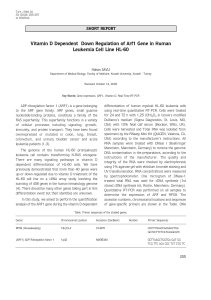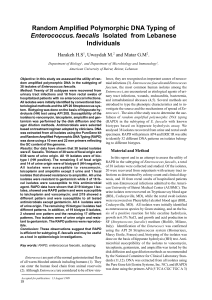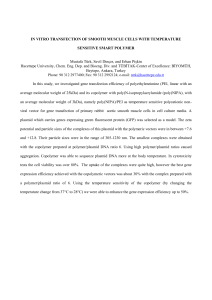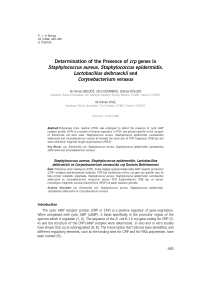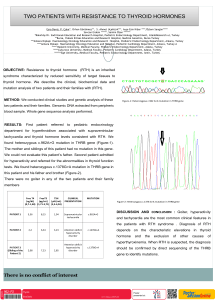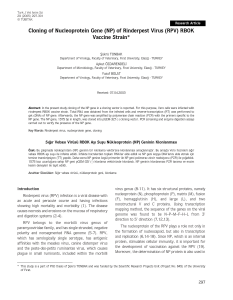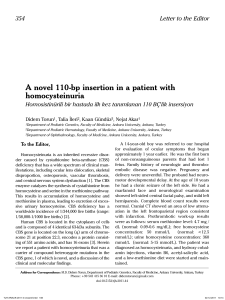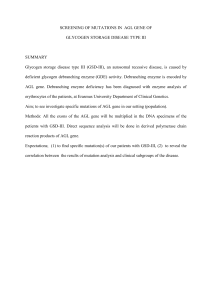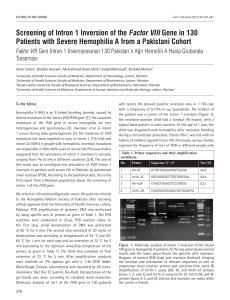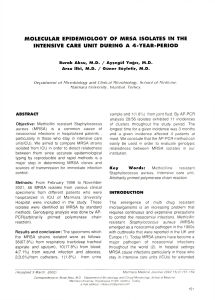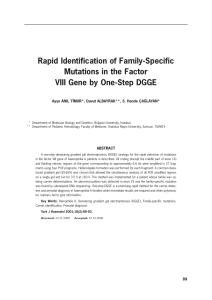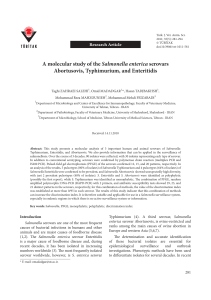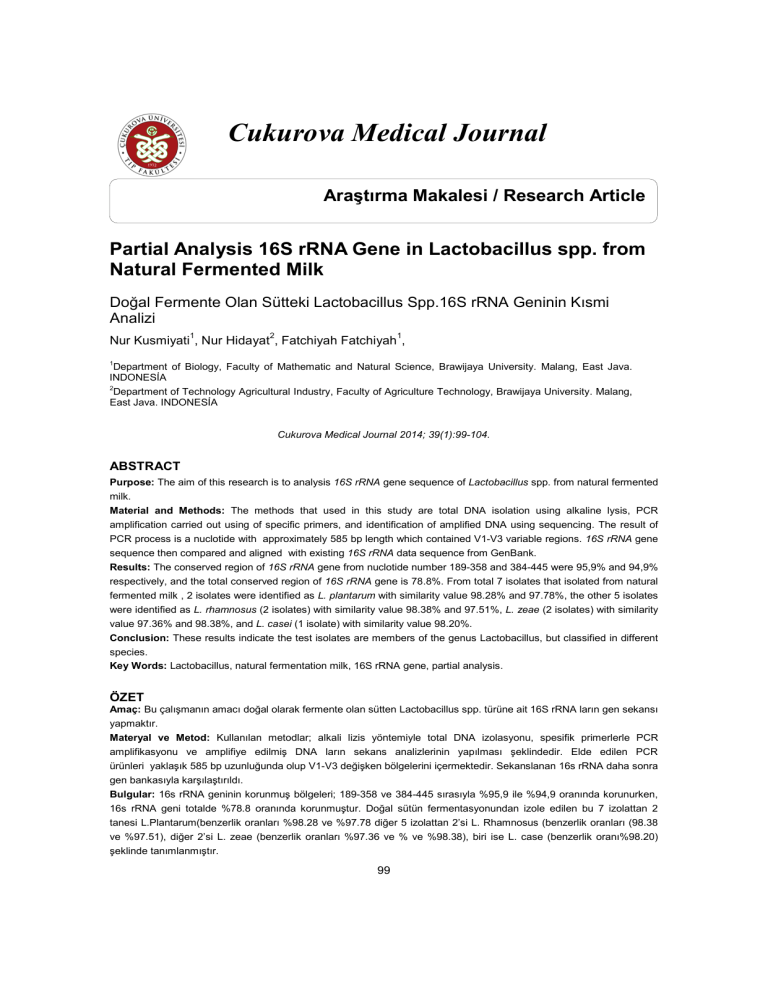
Cukurova Medical Journal
Araştırma Makalesi / Research Article
Partial Analysis 16S rRNA Gene in Lactobacillus spp. from
Natural Fermented Milk
Doğal Fermente Olan Sütteki Lactobacillus Spp.16S rRNA Geninin Kısmi
Analizi
1
2
1
Nur Kusmiyati , Nur Hidayat , Fatchiyah Fatchiyah ,
1
Department of Biology, Faculty of Mathematic and Natural Science, Brawijaya University. Malang, East Java.
INDONESİA
2
Department of Technology Agricultural Industry, Faculty of Agriculture Technology, Brawijaya University. Malang,
East Java. INDONESİA
Cukurova Medical Journal 2014; 39(1):99-104.
ABSTRACT
Purpose: The aim of this research is to analysis 16S rRNA gene sequence of Lactobacillus spp. from natural fermented
milk.
Material and Methods: The methods that used in this study are total DNA isolation using alkaline lysis, PCR
amplification carried out using of specific primers, and identification of amplified DNA using sequencing. The result of
PCR process is a nuclotide with approximately 585 bp length which contained V1-V3 variable regions. 16S rRNA gene
sequence then compared and aligned with existing 16S rRNA data sequence from GenBank.
Results: The conserved region of 16S rRNA gene from nuclotide number 189-358 and 384-445 were 95,9% and 94,9%
respectively, and the total conserved region of 16S rRNA gene is 78.8%. From total 7 isolates that isolated from natural
fermented milk , 2 isolates were identified as L. plantarum with similarity value 98.28% and 97.78%, the other 5 isolates
were identified as L. rhamnosus (2 isolates) with similarity value 98.38% and 97.51%, L. zeae (2 isolates) with similarity
value 97.36% and 98.38%, and L. casei (1 isolate) with similarity value 98.20%.
Conclusion: These results indicate the test isolates are members of the genus Lactobacillus, but classified in different
species.
Key Words: Lactobacillus, natural fermentation milk, 16S rRNA gene, partial analysis.
ÖZET
Amaç: Bu çalışmanın amacı doğal olarak fermente olan sütten Lactobacillus spp. türüne ait 16S rRNA ların gen sekansı
yapmaktır.
Materyal ve Metod: Kullanılan metodlar; alkali lizis yöntemiyle total DNA izolasyonu, spesifik primerlerle PCR
amplifikasyonu ve amplifiye edilmiş DNA ların sekans analizlerinin yapılması şeklindedir. Elde edilen PCR
ürünleri yaklaşık 585 bp uzunluğunda olup V1-V3 değişken bölgelerini içermektedir. Sekanslanan 16s rRNA daha sonra
gen bankasıyla karşılaştırıldı.
Bulgular: 16s rRNA geninin korunmuş bölgeleri; 189-358 ve 384-445 sırasıyla %95,9 ile %94,9 oranında korunurken,
16s rRNA geni totalde %78.8 oranında korunmuştur. Doğal sütün fermentasyonundan izole edilen bu 7 izolattan 2
tanesi L.Plantarum(benzerlik oranları %98.28 ve %97.78 diğer 5 izolattan 2’si L. Rhamnosus (benzerlik oranları (98.38
ve %97.51), diğer 2’si L. zeae (benzerlik oranları %97.36 ve % ve %98.38), biri ise L. case (benzerlik oranı%98.20)
şeklinde tanımlanmıştır.
99
Cilt/Volume 39 Yıl/Year 2014
16S Rrna Gene in Lactobacillus spp
Sonuç: Çalışmanın sonuçları test edilen izolatın Laktobailus genusuna ait olduğunu, fakat farklı türde sınıflandırıldığını
göstermiştir.
Anahtar Kelimeler: laktobacillus, doğal fermente süt, 16s rRNA, parsiyal analiz.
Lactobacillus isolation and incubated at 37 ºC for
48 h. Well-isolated colonies were picked from each
plate and transferred to MRS broth.
The sequence of 16S rRNA gene is aligned
with same gene of L.acidophilus
1001H
(JQ031741.1),
L.bulgaricus
ATCC-11842T
(FR683102.1),
L.rhamnosus
ATCC-7469T
INTRODUCTION
Lactobacillus are members of the lactic acid
bacteria, whose primary fermentation end product
is lactic acid. Lactobacillus are nutritionally
fastidious, and are associated with a large variety
of plants and animals. Lactobacillus are used
extensively for fermentation of plant material, dairy
1
products and meat . Generally Lactobacillus
dominate the non-starter lactic acid bacteria
(FR653106.1), L.zeae JCM-11302 (AB289313.1),
L.rhamnosus
JCM
8849
(AB690234.1),
L.plantarum JCM 1100 (AB239347.1).
(NSLAB) population in milk. Heterogeneity of
NSLAB strains with unique and diverse properties
represent a key factor for improving authenticity of
traditional milk, when compared to commercially
2.
available starter strains
Some Lactobacillus species have been
attributed with probiotic properties, implying living
micro-organisms which upon ingestion in certain
numbers exert health benefits beyond inherent
Ethical Consideration
This study was approved by animal research
ethics comitee, Brawijaya University, as a
member of
Indonesia.
Research
Ethics
committee
in
Procedure
Bacterial DNA from goat and cow natural
3
nutrition . This has added further incentive to
detailed microbiological, biochemical and genomic
4
studies of Lactobacillus .
Taxonomic analysis has already led to a
recognition of the unusual diversity of the genus
5
Lactobacillus and one objective of this study was
to extend the 16S rRNA phylogeny of the
fermentation milk samples was isolated according to
7
alkaline lysis method of Villalobos et al . Quality &
quantity DNA were measured by using NanoDrop
spectrophotometer
and
1%
agarose
gel
electrophoresis.
DNA isolate was amplified using Eub l6S
rRNA 7f, Lact S-G-Lab-0677-r and GC Clamp
6
Lactobacillus and investigate its correlation with
genome-based comparison. Lactobacillus group-
8
°
primer . PCR programs included hot start 94 C for
°
°
3 min, denaturation 94 C for 30 s, annealing 52 C
°
for 30 s, extension 68 C 1.5 min (30 cycles) and
specific primers were used to amplify the V1 to V3
regions of the 16S rRNA gene.
°
final extension 68 C 7 min. PCR products were
measured qualitatively using 2% agarose gel
electrophoresis.
The PCR product was purified using ethanol
absolute and 3 M of sodium acetate. After that
TM
PCR product was sequenced using bigDye
terminator cycling condition. Sequencing process
was conducted in German.
MATERIALS and METHODS
Subject
Raw unpasteurized milk samples from cow
and goat were collected from the local area of UPT
Singosari in a sterile screw cap tubes, processed
within 144 hours as product natural fermentation.
Milk fermentation samples were serially diluted in
peptone medium. Diluted samples were plated
onto De Man Rogosa Sharpe (MRS) medium for
100
Kusmiyati et al.
Cukurova Medical Journal
Data Analysis
(Pediococcus, Lactococcus, Eubacteriun, and
Leuconostoc) shows the position between forward
The sequences were compared with the
sequences deposited in the GenBank database
and reverse did not never met (data not shown).
using
the
BLAST
algorithm
(http://www.ncbi.nlm.nih.gov/BLAST/; 1). Data was
analyzed using MEGA5 (Molecular Evolutionary
Genetic Analysis version 5.0) software to
constructed phylogeny tree using Maximum
likelihood (ML) method, tree construction was
bootstrapped 1000x and BioEdit software for
conserved region analysis. The sequence data
were alignment using Clustal X in MEGA5
This indicated that the primary 7f and SG-Lab-0677
can only amplify V1 - V3 in the genus Lactobacillus.
software.
The amplicons could differentiate between bacterial
species Lactobacillus one another so often used for
identification. Primary in this study were used to
partially bacteria with 1-600 bp sequence of bases
on V1-V3 region of the 16S rRNA gene.
Topology of the phylogenetic tree shows all
test isolates is one clade genus Lactobacillus. The
Nucleotide bases of 16S rRNA gene were
Isolates G3 and C3 formed by one sister-clade with
L. plantarum, while the isolates G2, C2, G1, C1 and
G4 formed by one sister-clade with L. rhamnosus,
L. zeae, and L. casei. Sister-clade generated by
alignment with the program Clustal X. The Result
of NCBI Genebank reference sequence alignment
indicates that the 16S rRNA gene has a 585 bp
amplicon (Figure 9). Amplicons of 16S rRNA gene
the seven isolates with the reference species is
still in the same species but different subspecies.
The Isolates G3 and C3 have a close kinship
with L. plantarum, sequentially similarity value of
have the conserved regions base of 189-358 bp at
95.9% and 384-445 bp at 94.9% with 78.8% of
conserved sequences. Primary DNA can be used
to identify to species level when similar areas have
98.28% and 97.78%. The Isolates G2 and C2 have
a close kinship with L. rhamnosus, sequentially
RESULTS
similarity value of 98.38% and 97.51%. The
Isolates G1 and C1 have a close kinship with
L.zeae sequentially similarity value of JCM-11302
9
more than 70% . The similarity regions, indicates a
potential the area while the Lactobacillus group
amounted to 97.36% and 98.38%. While isolate
G4 have a close kinship with L.casei amounted to
variability can be used to identify the species level.
This indicated that the primary 7f and SG-Lab0677 can only amplify V1 and V2 in the genus
Lactobacillus.
Alignment of several genera of Lactic Acid
Bacteria other than the genus Lactobacillus
98.20%. Isolates
L.acidophilus and
were found not include
L.bulgaricus but produced
fermented milk product similar to a product
containing L.acidophilus and L.bulgaricus.
101
Cilt/Volume 39 Yıl/Year 2014
16S Rrna Gene in Lactobacillus spp
102
Kusmiyati et al.
Cukurova Medical Journal
Table 1. Similarity value of test isolates and reference isolates
Figure 1. 16S rRNA gene Lactobacillus in single colony from Lactobacillus by PCR with the primer 7f and the specific primer Lab-0677r
(A) Alignment results from data sequencing Lactobacillus isolate and Lactobacillus from GeneBank. (B) Phylogenetic tree based upon
the Maximum Likelihood method of partial 16S rRNA gene sequences (60 to 655 bp)
f 7 primer used to amplify the V1-V3 region of 16S
14
rRNA gene .
DISCUSSION
16S rRNA gene consists of highly conserved
Isolates with 16S rRNA gene similarity values
regions and hyper variable region. Highly
conserved region describe the level of
phylogenetic relationships, whereas the hyper
9,10
variable region shows the level of kinship . 16S
rRNA gene contains nine hypervariabel regions
of ≥ 99% can be are grouped into a single
9
species . Test isolates were found to have a value
of ≤ 99% similarity with the reference isolates.
These results indicate the test isolates are
members of the genus Lactobacillus, but classified
in different species. While according to the
phylogenetic species concept stated that a species
can be the same if the value of similarity more than
(V1-V9) which sequence diversity among different
bacteria. Region V1 is able to distinguish
Pediococcus sp., V2 and V3 best distinguish all
species of the genus except Enterobacteriaceae
11
bacteria levels . For identification purposes, the
necessary amplification using PCR and sequence
95% and declared a strain if the value is more than
15
99% similarity .
12
analysis of the bases at least 500 base pairs .
The presence of mutations or differences in
the sequence of bases will serve as a determinant
of bacterial identification at the genus and species
13
level . Primary SG-Lab-0677-r-f and primer 7 is
8
special to the genus Lactobacillus group . Specific
groups of Lactobacillus primer SG-Lab-0677-r and-
ACKNOWLEDGEMENT
The authors thanks to Directorate of General
Higher Education, Ministry of Education and
Culture of Indonesia for the “BUDN” scholarship
and Desentralized Program for Higher Education
2012-2014.
103
Cilt/Volume 39 Yıl/Year 2014
16S Rrna Gene in Lactobacillus spp
of an Artisanal Sicilian Cheese as Evaluated by 16S
rRNA
Analysis.
Appl.
Environ.
Microbiol.
2002;68:1882–92.
CONFLICTS OF INTEREST
The authors declare that there are no conflicts of
interest.
9. Drancourt M, Bollet C, Cariioz A, Martelin JP, Gayral,
& Raoult D. 16S Ribosomal DNA Sequence Analysis
of A Large Collection of Environmental and Clinical
Unidentifiable Bacterial Isolates. J. Gin. Microbial.
2000;38:3623-30.
REFERENCES
1. Tannock GW. A special fondness for Lactobacillus.
Appl Environ Microbiol. 2004;70:3189–94.
10. Bhattacharya D, Sarma S, Krishnan S, Mishra & Lal
B. Evaluation of Genetic Diversity among
Pseudomonas citronellolis Strains Isolated from Oily
Sludge-Contaminated Sites. Appl. Environ. Microbiol.
2003;69:1435-41.
2. Dellaglio F, Felis GE & Torriani S. Is the genus
Lactobacillus a single genus In LAB8 Symposium on
Lactic Acid Bacteria . Egmond aan Zee, Netherlands:
FEMS. 2005.
3. Guarner F. & Schaafsma GJ. Probiotics. Int J Food
Microbiol. 1998;39: 237–8.
11. Collins MD, Ash JAE, Farrow S, Wallbanks &
Williams AM. 16S ribosomal ribonucleic acid
sequence analyses of Pediacoccus and related taxa.
Description of Vagococcus fluvialis gen. J. Appl.
Bacteriol. 2006;67:453-60.
4. Klaenhammer TR, Barrangou R, Buck BL, AzcaratePeril MA & Altermann E. Genomic features of lactic
acid bacteria effecting bioprocessing and health.
FEMS Microbiol Rev. 2005;29:393–409.
12. Petrosino JF, Highlander S, Luna RA, Gibbs RA, &
Versalovic J. Metagenomic pyrosequencing and
microbial
identification.
Clinical
Chemistry.
2009;55:856-66.
5. Dellaglio F & Felis GE. Taxonomy of Lactobacillus
and bifidobacteria. Probiotics and Prebiotics:
Scientific Aspects , pp. 25–49. Edited by G. W.
Tannock. Norfolk, UK: Caister Academic Press.
2005.
13. Clarridge JE. Impact of 16S rRNA gene sequence
analysis for identification of bacterial on clinical
microbiology and infectious diseases. Clin Microbiol
Rev. 2004;17:840-62.
6. Hammes WP & Hertel C. The Genera Lactobacillus
and Carnobacterium .InThe Prokaryotes , release
3.15. Edited by M. Dworkin. 2005.
14. Heilig HGHJ, Erwin G, Zoetendal EG, Vaughan EE,
Marteau P, Akkermans ADL & Vos WM. Molecular
diversity of Lactobacillus spp. and other lactic acid
bacteria in the human intestine as determined by
specific amplification of 16S ribosomal DNA. Appl. &
Envir. Microbiol. 2002;68:114–23.
7. Villalobos DP, Bautista R, Canovas FM & Claros G.
Isolation of Bacterial Artificial Chromosome DNA by
Means of Improved Alkaline Lysis and Double
Potassium Acetate Precipitation. Plant Molecular
Biology Reporter. 2004;22:1–7.
8. Randazzo CL, Torriani S, Akkermans ADL, de Vos
WM and Vaughan EE. Diversity , Dynamics , and
Activity of Bacterial Communities during Production
15. Davis JL. Phylogenetitic, molecular variations, and
spesies concepts. Bioscience. 1996;46:502-10.
Yazışma Adresi / Address for Correspondence:
Dr. Fatchiyah Fatchiyah
Dept of Biology,
Faculty of Mathematics and Natural Sciences,
Brawijaya University
Malang, East Java, INDONESIA.
e-mail: [email protected], and [email protected]
geliş tarihi/received :05.09.2012
kabul tarihi/accepted:24.09.2013
104

